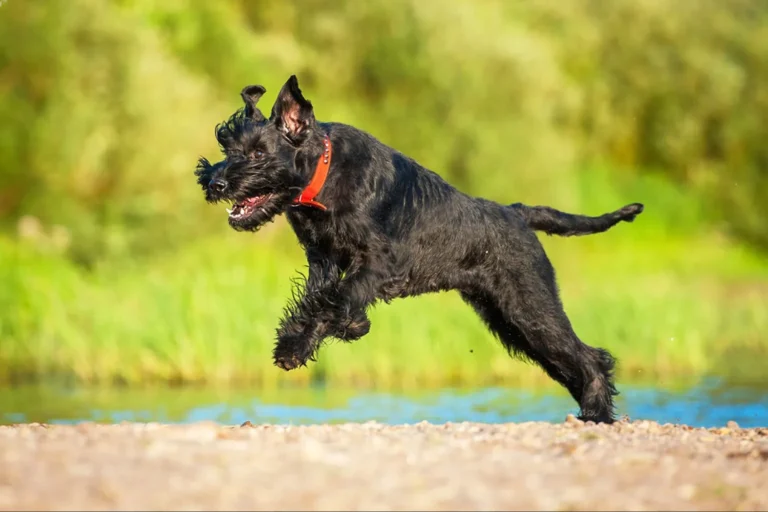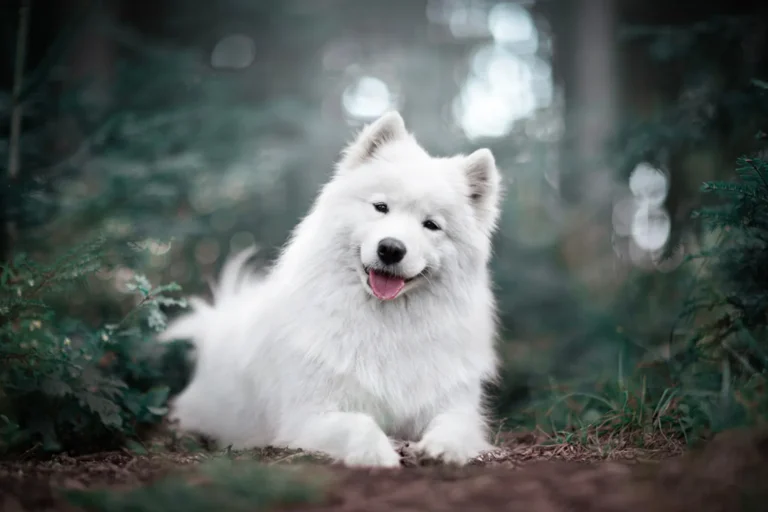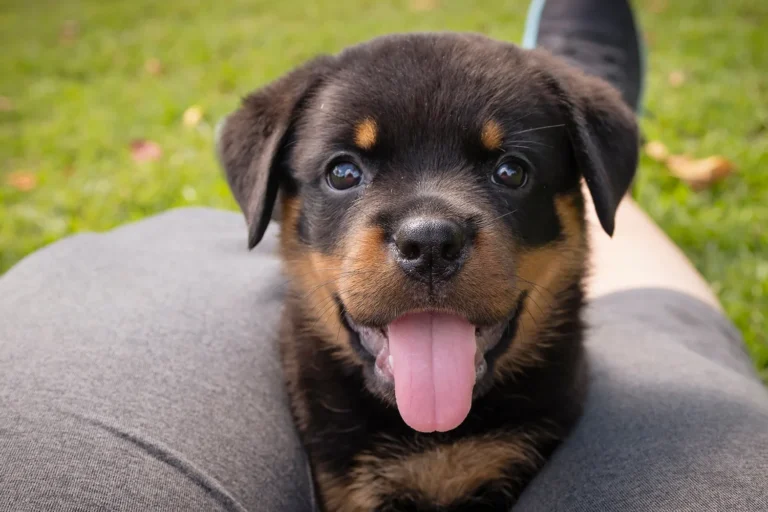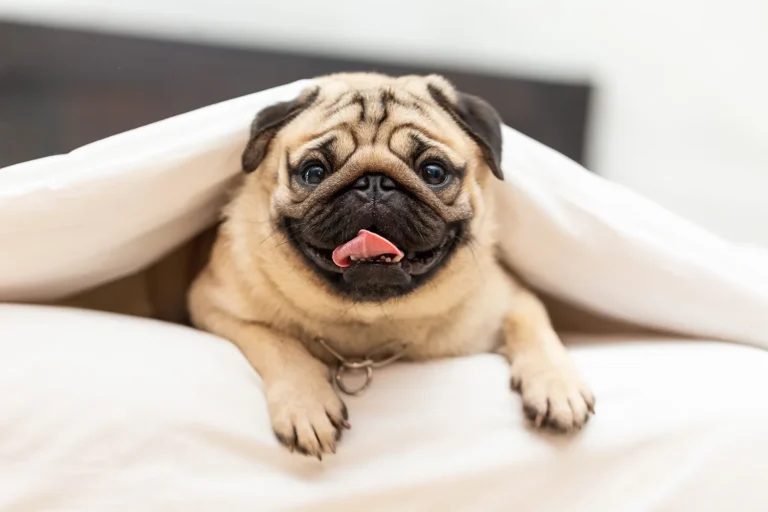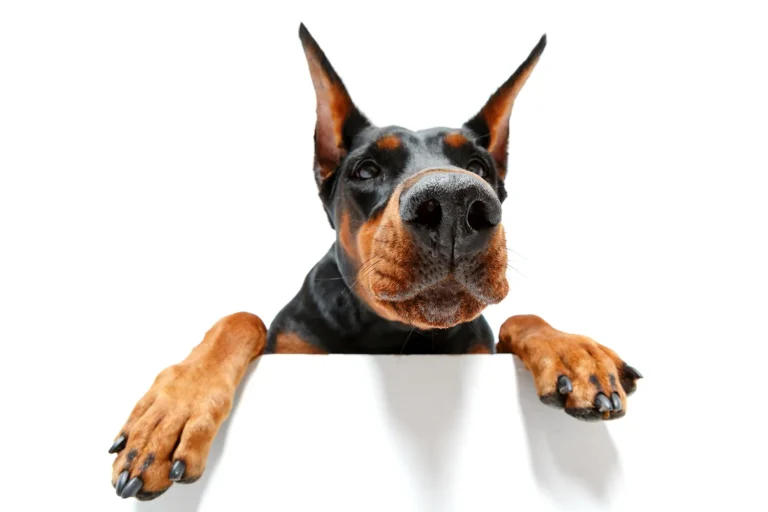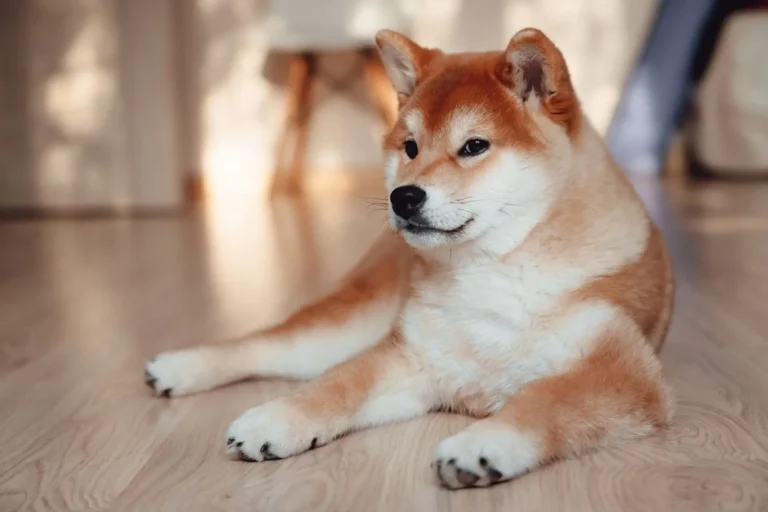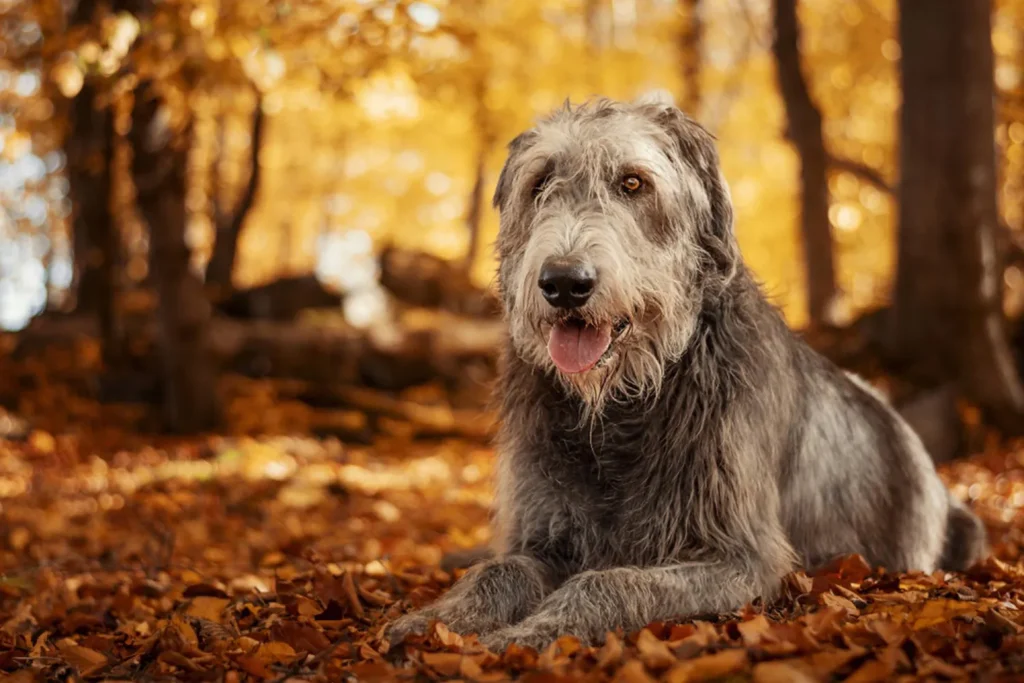
Here’s a friendly guide to help you decide if an Irish Wolfhound fits your life. We’ll cover size, temperament, exercise, grooming, and costs, plus practical tips and one quick story the first Wolfhound I met leaned on me like a weighted blanket.
History and Origin of the Irish Wolfhound
The first time I met an Irish Wolfhound, he leaned his great shaggy head into my chest like we were old friends. For a dog that can look you straight in the eye when you’re sitting on a park bench, they carry an old, quiet gentleness. That calm has deep roots. Irish Wolfhounds are among the oldest dog breeds, with ancestors working in Ireland for well over a thousand years. Early monks helped shape them into powerful hunters, and these hounds earned their name tracking and bringing down wolves that threatened livestock. They weren’t a one task dog either; they were used on Irish elk and boar, and often rode into battle with chieftains part guardian, part symbol of status and courage.
Their fame traveled far beyond Ireland. I once read a letter from the 1600s praising the Irish Wolfhound as a gift fit for kings, which makes sense, since Irish leaders frequently presented them to visiting dignitaries. Ironically, that generosity helped drain their numbers. Then came the perfect storm: wolves disappeared from Ireland, the Great Famine of 1845 devastated the country, and exports continued. By the mid-1800s, Wolfhounds were perilously close to vanishing.
What saved them was a mix of determination and careful breeding. Dedicated enthusiasts gathered the few remaining Wolfhounds and rebuilt the line by crossing them with tall, athletic breeds such as the Great Dane, Scottish Deerhound, Borzoi, and dogs then known as Tibetan Wolfdogs. A breeder I spoke with in County Wicklow told me they still prize the same traits those early monks relied on: courage, steadiness, and a kindly nature.
You can feel that history in how they move unhurried, purposeful. If you ever bring one home, remember their past. Give them room to stretch those long legs, a safe fence for their old hunting instincts, and plenty of quiet companionship. They’re gentle giants, but their story is epic.
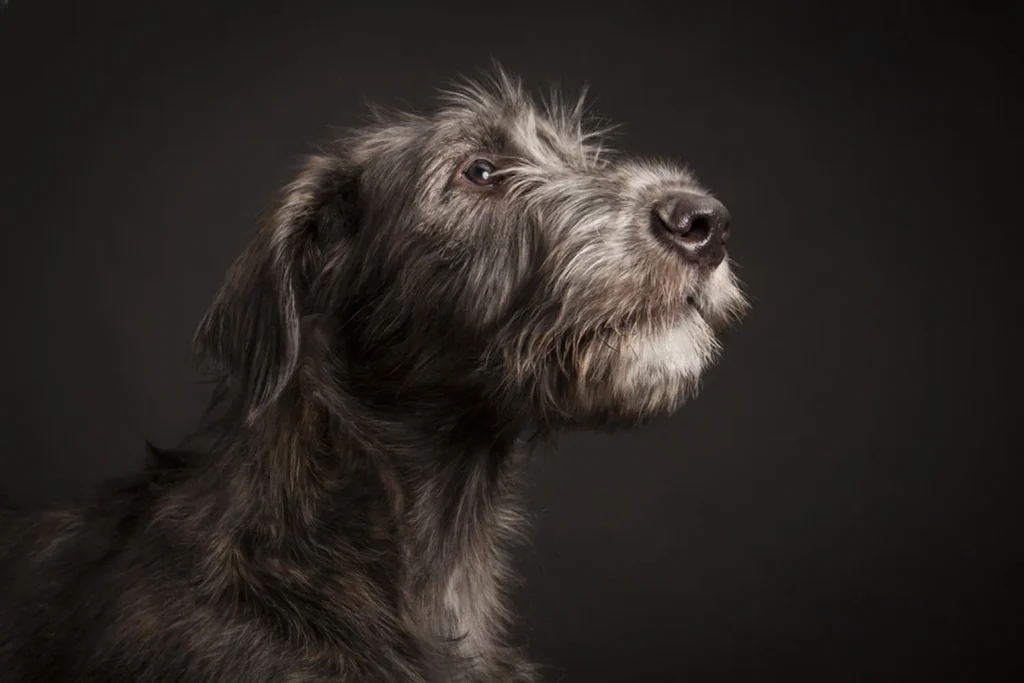
What Is the Irish Wolfhound?
Spotting an Irish Wolfhound in person is one of those stop and stare moments. They’re the tallest dog breed, with legs that seem to go on forever, yet they’re anything but clumsy. Built sturdy and strong, they move with a quick, effortless stride that makes you forget just how big they are.
Their coat is rough and hard to the touch, the kind that shrugs off wind and drizzle. It comes in classic colors like grey and brindle, but you’ll also see black, white, red, or fawn. The silhouette is unmistakable: a long, noble head, a deep chest built for endurance, an arched loin, and a long, gently curved tail that swishes like a metronome.
I remember meeting a Wolfhound named Finn at the park at first glance I thought someone had brought a small horse. He leaned into me for a scratch with the sweetest, most polite nudge. If you’re thinking about life with one, plan for space (those legs stretch across a whole sofa) and keep your coffee table clutter to a minimum tails at that height can be enthusiastic. A good weekly brushing keeps the coat tidy, and a long, steady walk will make this majestic giant content and calm back at home.
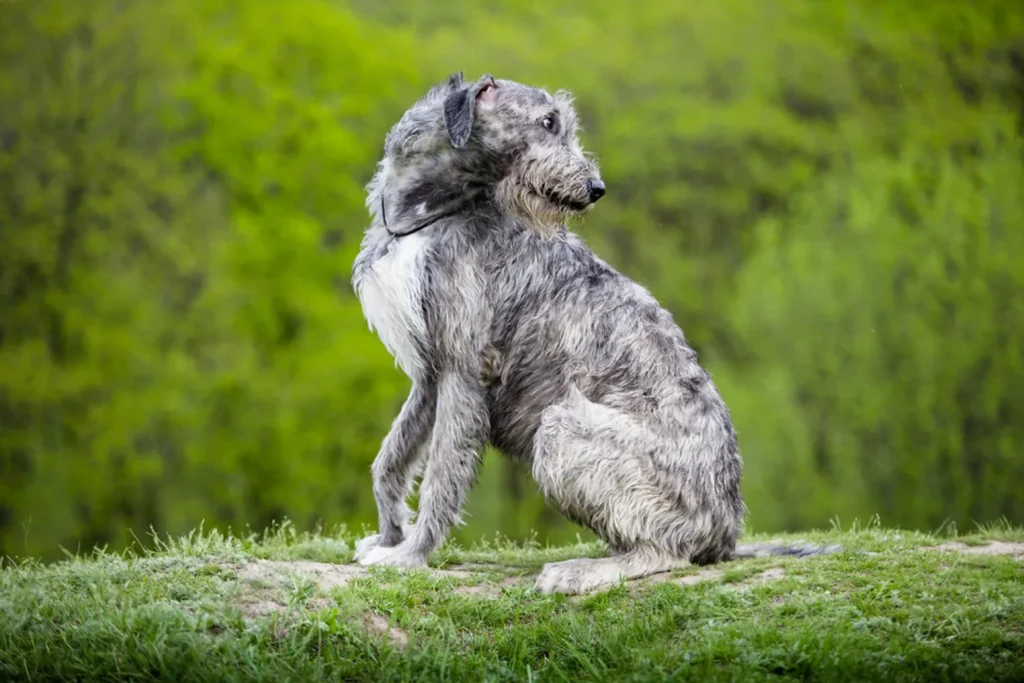
Who Is an Irish Wolfhound Best For?
Irish Wolfhounds are the definition of gentle giant, but living with one isn’t for everyone. Their sheer size means you need confidence on the leash and a steady hand with training. I remember dog sitting a Wolfhound named Finn who would lean on me like a 140-pound lapdog adorable, but if you aren’t ready for that kind of heft, it’s a lot to manage. For first time dog owners, the learning curve can feel steep, so these dogs tend to thrive with people who’ve handled large breeds before.
In the right home, though, they’re wonderful family companions. When socialized early, they’re calm, tolerant, and sweet with kids. Just be mindful of the “tail at coffee table level” effect one happy swish and your snacks may go flying. A fenced yard helps, as does a household that can give them company; they’re people oriented and don’t love being left alone for long stretches.
Plan on roughly two hours of daily exercise. That might look like long, steady walks plus some safe off leash gallops in a secure area Wolfhounds are sighthounds and love to stretch those long legs. Mental work matters too: scent games, puzzle toys, and gentle training sessions keep their brains busy. If you’re bringing home a puppy, ask your vet about safe exercise as they grow; giant breeds need a thoughtful approach while their joints develop.
Practical notes: you’ll want space (a big bed, a roomy car), a budget for big dog food and vet care, and a commitment to consistent leash manners. As for guarding, their size and deep, booming bark make a strong deterrent. The ones I’ve met are friendly by nature, but most strangers won’t test their resolve when an Irish Wolfhound is watching the door. If you’re active, experienced, and ready to share your life and your couch with a massive, loyal companion, a Wolfhound can be a dreamy match.
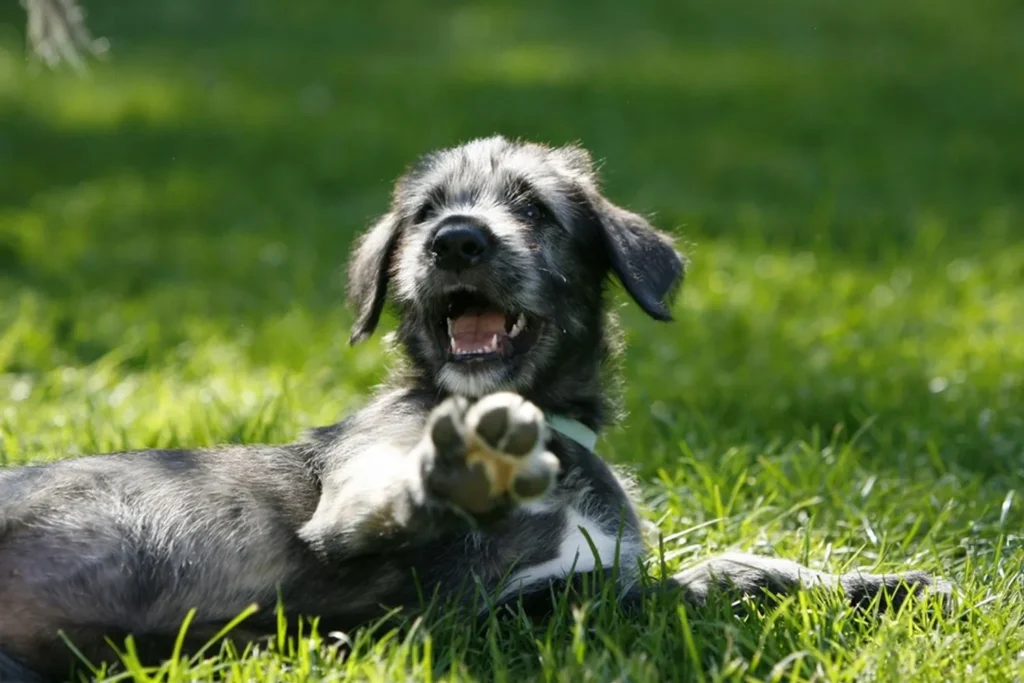
Irish Wolfhound Grooming & Shedding
Irish Wolfhounds shed all year, and those long, wiry hairs seem to find their way onto every sweater and sofa. Regular brushing keeps the tumbleweeds at bay and the coat looking healthy. I joke that my friend’s Wolfhound, Fergus, leaves a little “Irish snow” on my black jeans every visit, but a good brush before guests arrive makes a world of difference.
A slicker brush followed by a metal comb works well for their rough coat, lifting out dead hair and preventing tangles behind the ears, under the collar, and in the feathering on the legs. Two or three short sessions a week is easier than one marathon grooming day. I like to brush outside so the breeze can carry the loose hair away instead of into the living room. After muddy walks, a quick once over with a damp cloth on the legs and belly helps, and don’t forget the “beard” a wipe after meals keeps crumbs and drool from matting. One Wolfhound I met at a meetup leaned his whole weight into me while I brushed; it’s like grooming a polite small horse, so plant your feet.
Bathing such a gentle giant can feel daunting, but you won’t need to do it often about every six months, or whenever they get truly stinky or roll in something questionable. Set yourself up for success: a non slip mat, a handheld sprayer, and two big towels. I’ve even used a lick mat with a smear of peanut butter on the shower wall to keep them happily occupied. Between baths, spot cleaning and a rinse of muddy paws usually does the trick.
Don’t forget the little things that make a big difference: brush teeth regularly (daily is ideal, a few times a week is still great) and offer dental chews as a backup. Trim nails every 2-3 weeks if you hear tap tap on the floor, they’re due. A grinder can be gentler on big, thick nails, and I always keep styptic powder nearby just in case. Check ears weekly and clean with a vet approved solution; lift the ear flap, wipe what you can see, and never poke deep. While you’re at it, part the fur and scan the skin for burrs or hot spots. A few consistent habits, and your Wolfhound will look and smell like the noble companion they are.
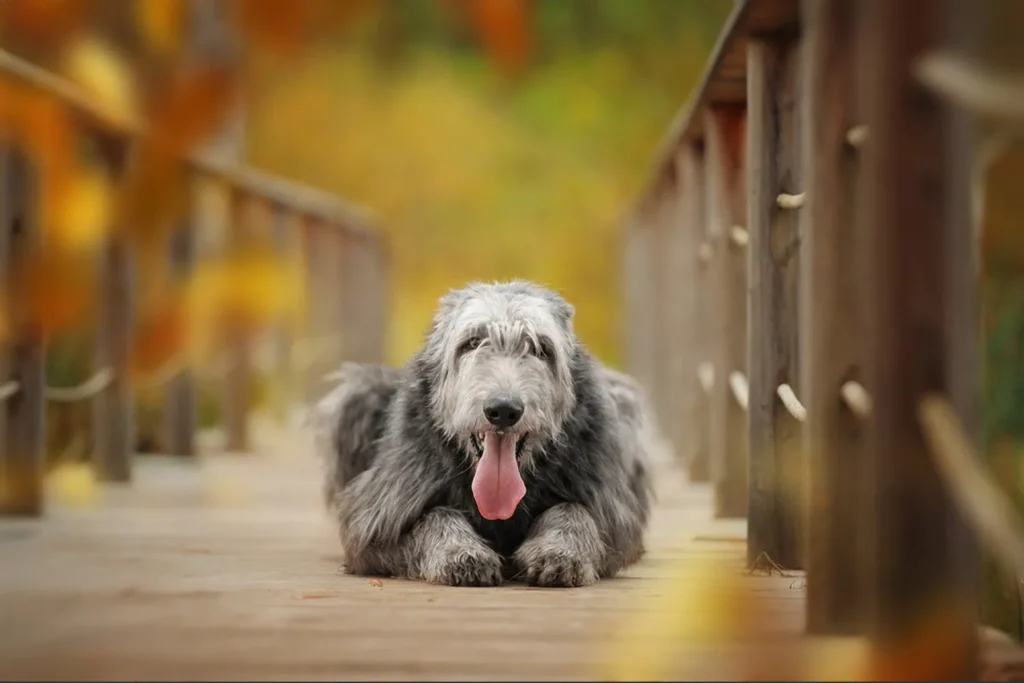
Do Irish Wolfhounds Bark a Lot?
Irish Wolfhounds aren’t big talkers. Most of the ones I’ve met are more likely to communicate with a dramatic sigh than a flurry of barks. That said, they will voice an opinion now and then. Expect an occasional deep, single “woof” when the doorbell rings or when a squirrel gets a little too cheeky in the yard. My neighbor’s Wolfhound, Finn, only really “announced” visitors one bass drum boom and then he was done, tail wagging like he’d just solved a mystery.
If you do get more barking than you’d like, training goes a long way. I like to teach a quiet cue by first rewarding a calm moment after a bark one second of silence, mark it with a yes, treat, then build to longer pauses. Pairing it with a place cue (bed or mat by the door) turns chaos into a routine: visitor arrives, dog goes to mat, gets paid for being the world’s best greeter. Avoid shouting over them; it can sound like you’re barking back. Instead, stay calm, redirect, and reward the behavior you want.
A well exercised Wolfhound is usually a quiet Wolfhound. Gentle walks, a few short play bursts, and some brain games like scent snuffle mats help prevent boredom barking. If your typically mellow hound starts vocalizing more than usual, check for changes at home, new noises outside, or even discomfort; sometimes a vet chat or a little extra reassurance makes all the difference.
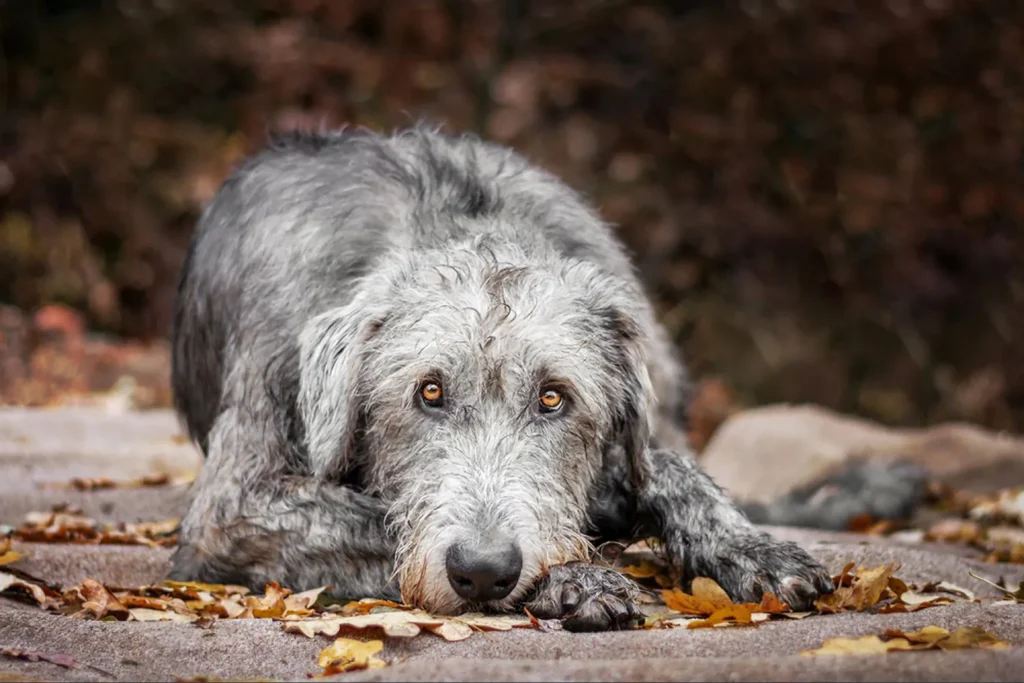
How Big Do Irish Wolfhounds Get? Height and Weight Guide
When you see an Irish Wolfhound in person, you understand why people call them gentle giants. Measured at the shoulder (the withers), adult males typically stand between 81 and 89 cm tall, while females come in around 76 to 86 cm. Yes, some girls are every bit as statuesque as the boys. I remember the first time I dog sat a friend’s Wolfhound he calmly rested his chin on my kitchen counter like he’d been invited to help with dinner. If you’re used to medium dogs, this is a different scale entirely. https://en.wikipedia.org/wiki/Irish_Wolfhound/
As for weight, males usually land between 54 and 82 kilos, and females between 48 and 64 kilos. To put that in perspective, that can be about as heavy as a grown adult or, in my house, two very surprised beagles combined. These dogs carry their size with a lot of grace, but you feel it when they lean in for a cuddle. My advice: invest in a sturdy, supportive dog bed and make sure your car and doorways can comfortably accommodate a long legged passenger.
A quick measuring tip I learned the hard way: stand your Wolfhound square on a flat surface and measure straight up to the top of the shoulder not the head. And don’t worry if a young Wolfhound looks lanky for a while; they grow in stages and often fill out later. Keep them on the lean side while they’re maturing, stick to steady, gentle exercise, and check their weight regularly so those big joints stay happy. With the right setup at home non slip rugs, a raised water bowl, and space to sprawl living with a Wolfhound feels like sharing your life with a very polite, very tall roommate who happens to adore you.
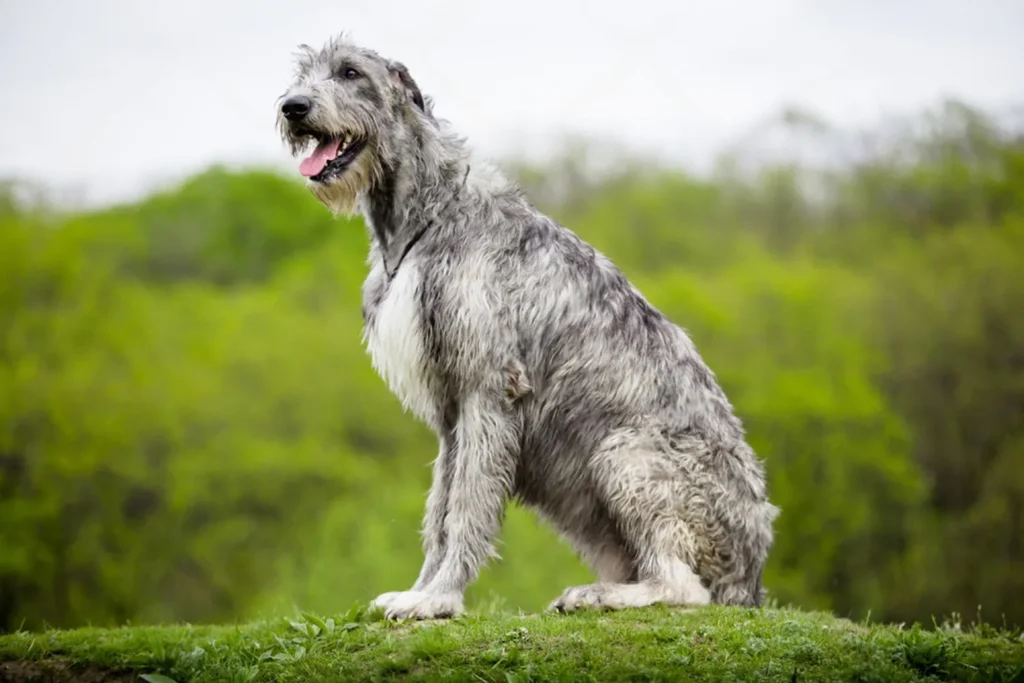
Are Irish Wolfhounds Easy to Train?
Irish Wolfhounds are clever, gentle souls, and most take to training quite well especially when you keep it positive and fun. They respond beautifully to praise and tasty treats, and short, upbeat sessions work best. A friend’s Wolfhound had “sit” down in a couple of days; we kept it light and he practically wagged through every lesson.
Start early with puppy classes and plenty of calm socializing. Because they grow so big, focus on polite greetings, loose leash walking, and a solid recall. Avoid harsh corrections these dogs are sensitive and can shut down. Practice impulse control in safe, fenced areas (a long line is your friend), and be consistent. With patience and kindness, they turn into wonderfully well mannered companions.
How Do Irish Wolfhounds Behave? A Look at Their Temperament and Personality
For a dog that can block out the sun when they stroll past the window, Irish Wolfhounds are famously calm and tender hearted. I once met a Wolfhound named Maeve at a Sunday market, and she did that classic gentle “lean” against my legs like we were old friends. Around the house, they’re more likely to be quiet shadows than chaos makers, happy to stretch out on a rug and watch life go by.
They usually get along beautifully with other dogs. A friend’s Wolfhound was the peacekeeper at her playgroups huge, polite, and oddly diplomatic. That said, their size means play should be supervised, especially with small or timid dogs. Start polite leash manners early; when a dog this big decides to say hello, it’s better if you’re both on the same page. They respond best to calm, positive training Wolfhounds are sensitive souls and don’t do well with harsh corrections.
Do keep their prey drive in mind. They’re sighthounds, and a darting squirrel or rabbit can flip a switch. I’ve seen a Wolfhound go from mellow to missile in a heartbeat. Use a secure fenced area, long lines for practice, and teach solid cues like “leave it” and “watch me.” If you have cats or small pets, plan slow introductions and safe zones. With thoughtful training and management, you get the best of both worlds: a peaceful companion with a gentle heart and impressive manners.
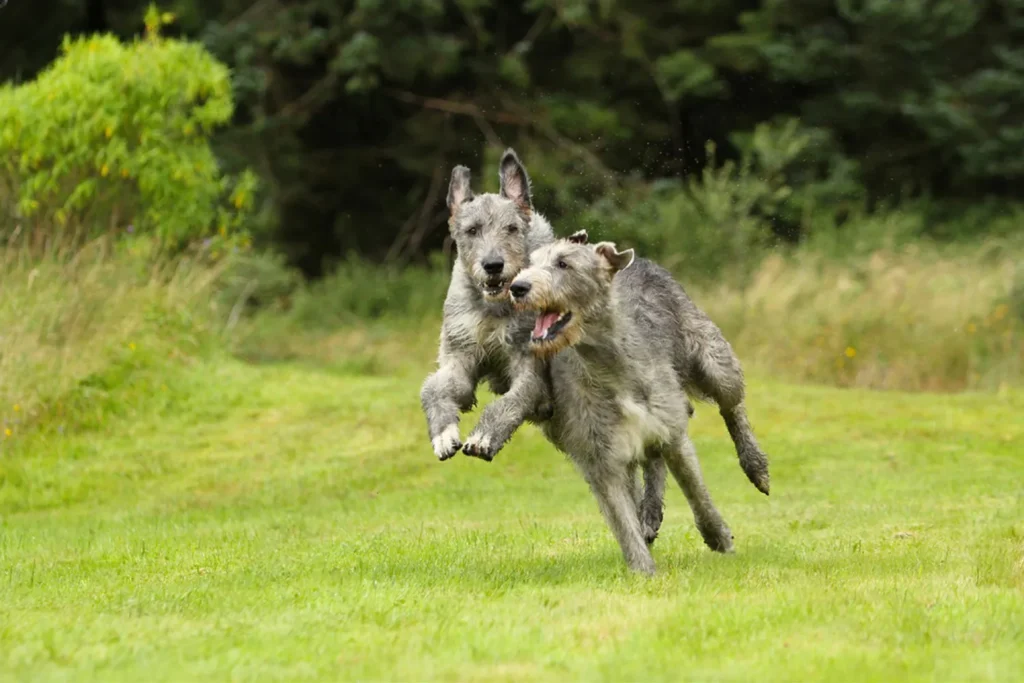
Do Irish Wolfhounds Have Common Health Issues?
Irish Wolfhounds are generally healthy, gentle giants, but like all large breeds, they do have a few conditions they’re more likely to face. Living with big dogs has taught me two things: know the risks, and build good habits early. It makes life calmer for you and much more comfortable for them.
Hip Dysplasia
This one shows up in many large breeds. The ball and socket of the hip don’t fit together just right, which can lead to pain and arthritis over time. You might notice stiffness getting up, a “bunny hop” gait, or sore hips after play. Keeping your Wolfhound lean, sticking to low impact exercise like long, steady walks, and providing an orthopedic bed can help a lot. Some dogs benefit from joint supplements and physical therapy; severe cases may need corrective surgery. A friend’s Wolfhound, Bran, did hydrotherapy after surgery watching that big, happy head bobbing along in the pool was both adorable and surprisingly effective.
Elbow Dysplasia
Similar idea, different joint. It’s less common than hip dysplasia, but it can still cause front leg lameness and stiffness. Early diagnosis matters your vet may recommend imaging, rest, controlled exercise, and in some cases surgery. I learned to pause fetch games before a limp appears rather than after.
Anesthesia Sensitivity
Sighthounds, including Wolfhounds, can be more sensitive to anesthesia. That doesn’t mean they can’t have procedures; it just means you want an experienced vet who tailors the drugs and the dose to this breed and provides careful monitoring. I always ask for pre anesthetic bloodwork, IV fluids, and temperature support. For peace of mind, I keep a simple “medical notes” file on my phone with my dog’s weight, medications, and any past anesthesia details.
Heart Disease (Dilated Cardiomyopathy)
Big body, big heart sometimes literally. In dilated cardiomyopathy, the heart muscle weakens and the chambers enlarge, making the heart less efficient. Signs can be subtle at first: tiring faster on walks, coughing at rest, or fainting spells. If something feels “off,” don’t wait your vet can check with an ECG or echocardiogram. I like to get a baseline cardiac check in middle age so we can spot changes sooner rather than later. Medication and lifestyle adjustments can make a meaningful difference.
Liver Shunt
A liver shunt means blood bypasses the liver instead of being filtered, allowing toxins to build up. It often shows up in young dogs as poor growth, odd behavior after meals, or intermittent tummy upset. If I were bringing home a Wolfhound puppy, I’d ask the breeder about bile acid testing. Treatments range from diet and medications to surgery, depending on the type of shunt.
Fibrocartilaginous Embolic Myelopathy (FCE)
This scary sounding condition can cause sudden weakness or paralysis in the hind legs when a bit of cartilage blocks the spinal cord’s blood vessels. It’s not typically painful after the initial event, but it is an emergency. Some dogs improve with time and dedicated rehab. A neighbor’s Wolfhound, Niamh, went from dragging a paw to trotting carefully over a few months thanks to patience, floor mats, and a great physical therapist.
Osteochondrosis Dissecans (OCD)
OCD affects cartilage growth in joints, leading to pain and stiffness, especially after exercise. Diet can play a role rapid growth and imbalanced nutrition don’t help, and high protein, overly rich diets may contribute. Stick with a high-quality giant breed puppy formula, avoid overfeeding, and ask your vet before adding supplements. Gentle, consistent exercise beats weekend warrior antics every time.
Progressive Retinal Atrophy (PRA)
PRA is a degenerative eye condition that can lead to blindness. You might first notice your dog hesitates in low light or bumps into things at night. There’s no cure, but dogs adapt remarkably well if you keep furniture in predictable places, use verbal cues, and keep walk routes consistent. I once taught a vision impaired foster to follow a soft “tap tap” of my toes on hardwood she trotted along like a champ.
Osteosarcoma
This aggressive bone cancer is, unfortunately, more common in giant breeds. A sudden, persistent limp or swelling on a limb deserves an immediate vet visit. X rays can be very telling. Treatment often involves amputation and chemotherapy, and your veterinary team will help you balance options with comfort and quality of life. It’s a tough road; having a support network (and plenty of soft blankets) helps.
Bloat (Gastric Dilatation Volvulus)
Bloat is an emergency that can turn life threatening very quickly. The stomach fills with gas and may twist, trapping that gas and cutting off blood flow. Risk can go up when a dog wolfs down one huge meal and then drinks a lot or exercises vigorously. Practical prevention tips I swear by:
– Feed smaller, more frequent meals
– Use a slow feeder bowl for speedy eaters
– Keep things calm for an hour before and after meals
– Learn the signs: restlessness, tight swollen belly, non productive retching, drooling, sudden distress
Talk to your vet about a preventive gastropexy, especially if your Wolfhound is already going under anesthesia for another procedure. One of my Wolfhounds tried to invent post dinner zoomies; I started setting a “quiet time” timer, and it became our cozy cuddle hour instead.
A few big dog care habits that pay off
– Keep them lean. Extra pounds are tough on joints and the heart.
– Choose joint friendly exercise. Long walks, soft surfaces, and swimming beat high impact sprints.
– Plan ahead for anesthesia. Share breed info, previous records, and discuss monitoring.
– Ask about screening. Hips and elbows (imaging), eyes (exam), and heart (echo/ECG) can catch things early.
– Consider pet insurance while they’re young and healthy it’s been a stress saver for me more than once.
– Work with responsible breeders who do health testing and are transparent about their dogs’ histories.
None of this is meant to scare you off Wolfhounds are soulful, gentle companions who fill a home with calm joy (and very large naps). Being aware of the common health issues just helps you spot little changes early, partner closely with your vet, and keep your lanky friend comfortable for as many good years as possible.
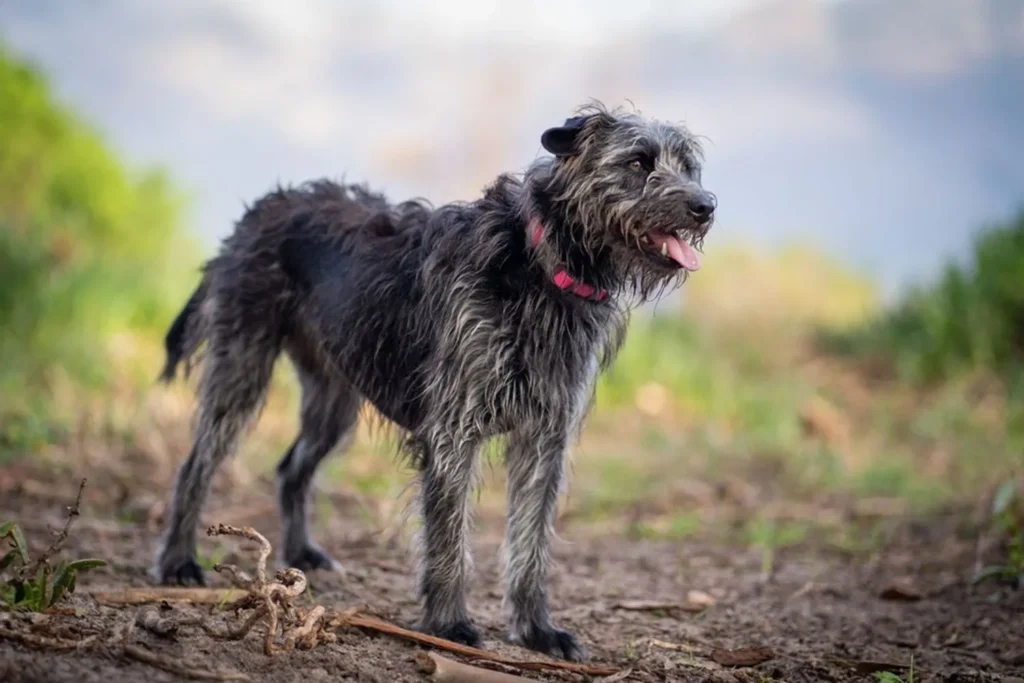
What Is the Lifespan of an Irish Wolfhound?
Irish Wolfhounds typically live around 6 to 10 years, which is pretty normal for giant breeds. With thoughtful care, you can often help them reach the higher end of that range. Keep them lean on a high-quality diet, stick to steady, gentle exercise, and avoid hard impact on young joints. Regular vet checkups are a must, and a cozy bed for those big bones goes a long way. My neighbor’s Wolfhound, Finn, made it to 10 thanks to slow, scenic walks and careful weight management proof that everyday habits add up.
How Much Should an Irish Wolfhound Eat?
Irish Wolfhounds are gentle giants with equally giant appetites, but feeding them is more about smart routines than just piling on the kibble. Most adults do well on a total of four to eight cups of high-quality dry dog food per day, depending on their size, age, and activity level. That sounds like a lot because, well, it is these dogs are huge. The key is not to serve it all at once. Split their daily amount into two meals to help minimize the risk of bloat. I do a calm breakfast and a quiet dinner, then keep things low key for a bit after meals. No zoomies or fetch right after eating has been a good rule of thumb in my house.
I like to measure portions with an actual measuring cup my friend’s Wolfhound, Finn, could easily “convince” you he needs a little extra with those soulful eyes. A slow feeder bowl can help if your dog hoovers kibble like a vacuum, and I often add a splash of water to the food so they don’t inhale it too fast. Keep an eye on body condition rather than the number on the bag: you want a visible waist and ribs you can feel but not see sharply. If your Wolfhound is filling out too fast or looking a little lean, adjust by half cup steps and watch for changes over a week or two. Treats count toward the daily total (I know, I know those big faces are persuasive), so factor them in.
Regular vet checkups are your best friend here. Wolfhounds grow a lot and keep changing as they mature, and your vet can tailor a diet plan and help you tweak it as your dog moves from lanky teenager to sturdy adult. Brand to brand calorie counts vary, so those four to eight cups are a guideline, not a law. I’ve also found that stool quality, energy level, and coat condition tell you a lot if one of those goes off, it’s time to revisit the plan. With steady portions, two calm meals a day, and a vet on board, you’ll keep that giant heart and giant tummy happy.
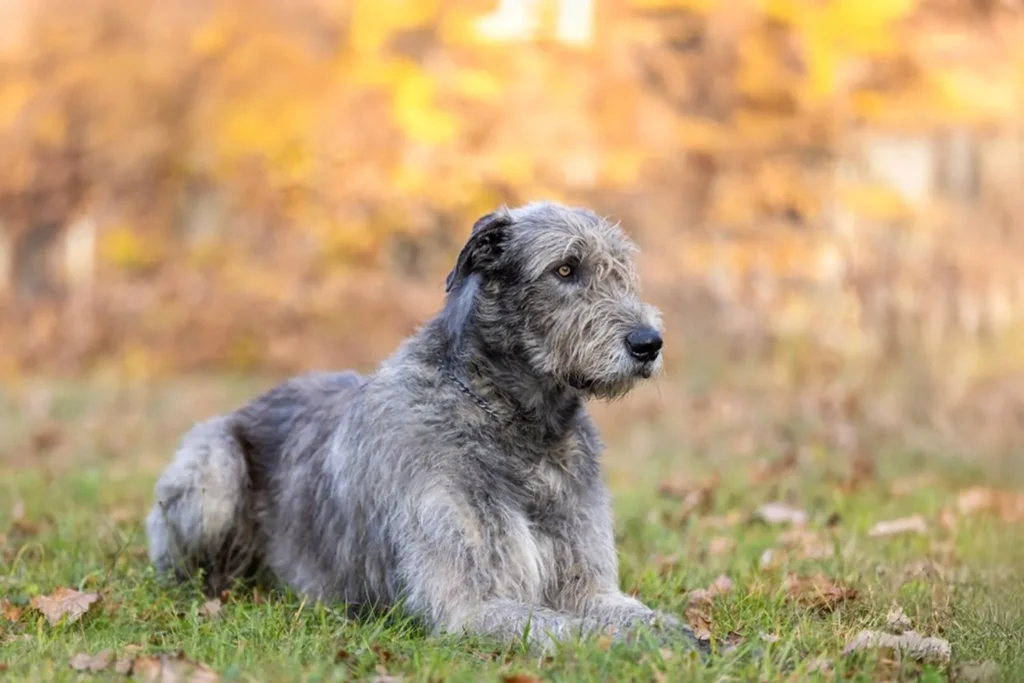
Irish Wolfhound FAQs
Is an Irish Wolfhound ideal for a first time dog owner?
They’re wonderfully gentle and usually eager to learn, but their sheer size makes them a handful for brand-new owners. Picture a puppy that can rest its chin on your countertop by the time it’s a teenager sweet as sugar, but still capable of bowling you over if it forgets its manners. Training from day one is non negotiable. I always teach “four paws on the floor” and calm greetings right away; even a friendly jump from the tallest breed can cause accidental injury. An experienced handler is usually better equipped to manage big dog logistics: sturdy equipment, consistent training, and the confidence to guide a giant. If your heart is set on a Wolfhound and you’re new to dogs, consider lining up a good trainer, enrolling in a puppy class, and practicing impulse control games early. My friend’s Wolfhound learned to settle on a mat by the front door, which saved many a delivery driver from being enthusiastically toppled.
Do Irish Wolfhounds suffer from separation anxiety?
Any dog can struggle with being left alone, so it’s smart to think about your daily routine before bringing one home. Training absolutely helps practice short, calm departures and returns, and avoid big emotional goodbyes that make leaving a whole event. If you must head out, exercise first. A long walk and a little playtime work wonders; my routine was a sniffy stroll followed by a stuffed puzzle toy, and I’d come home to a snoring giant. If your Wolfhound gets destructive, set them up in a safe area where they can’t wreck your sofa and make sure they have appropriate chew toys. Even with training, though, long stretches alone aren’t ideal, so a pet sitter, dog walker, or a trusted neighbor can be a lifesaver.
Are Irish Wolfhounds hypoallergenic dogs?
No Irish Wolfhounds aren’t hypoallergenic. They shed, thanks to that thick, textured coat, and you will notice hair on your clothes and furniture. Regular brushing keeps the tumbleweeds down and helps the coat stay healthy. I keep a brush by the door and do a quick once over after walks; it’s amazing how much dust and fluff you catch. If allergies are a concern, spend time around the breed before committing, and consider other breeds if symptoms flare.
Will an Irish Wolfhound need professional grooming?
Despite their size, they’re fairly low fuss. Routine care brushing to remove dead hair and tangles, nail trims, tooth brushing, and ear cleaning is all manageable at home with a little practice. Baths only need to happen a few times a year, though getting an elephant sized sweetheart into the tub can be an adventure. I’ve done backyard hose baths in warm weather with two towels and a non slip mat at the ready. Professional grooming isn’t a must for Wolfhounds, but an occasional visit can make life easier, especially for nail trims or a thorough tidy up before guests. Think of it as choosing convenience, not necessity.
Disclaimer:
This article is for informational purposes only and doesn’t replace professional veterinary or training advice. Always consult a certified vet or dog trainer for guidance specific to your pup.
